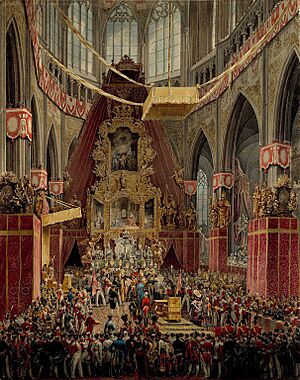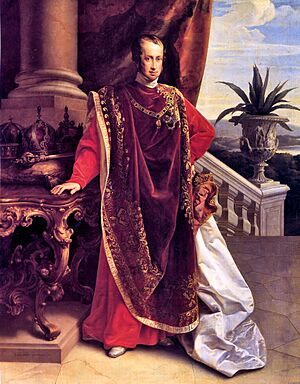Ferdinand I of Austria facts for kids
Quick facts for kids Ferdinand I & V |
|||||
|---|---|---|---|---|---|

Portrait by Eduard Edlinger (1843)
|
|||||
| Emperor of Austria King of Hungary (more...) |
|||||
| Reign | 2 March 1835 – 2 December 1848 | ||||
| Coronations | 28 September 1830, Pressburg 7 September 1836, Prague 6 September 1838, Milan |
||||
| Predecessor | Francis I | ||||
| Successor | Franz Joseph I | ||||
| Head of the Präsidialmacht Austria | |||||
| In office 2 March 1835 – 12 July 1848 |
|||||
| Preceded by | Francis I | ||||
| Succeeded by | Franz Joseph I | ||||
| Born | 19 April 1793 Vienna, Archduchy of Austria, Holy Roman Empire |
||||
| Died | 29 June 1875 (aged 82) Prague, Austria-Hungary |
||||
| Burial | Imperial Crypt | ||||
| Spouse | |||||
|
|||||
| House | Habsburg-Lorraine | ||||
| Father | Francis II, Holy Roman Emperor | ||||
| Mother | Maria Theresa of Naples and Sicily | ||||
| Religion | Roman Catholicism | ||||
| Signature | |||||
Ferdinand I (born April 19, 1793 – died June 29, 1875) was the Emperor of Austria from March 1835 until he gave up his throne in December 1848. He was also the King of Hungary, Croatia, and Bohemia (where he was known as Ferdinand V). He held many other important titles too. People called him The Benign or The Benevolent because he was known for being kind and well-meaning, even though he wasn't very active in ruling.
Ferdinand became emperor after his father, Francis I, passed away on March 2, 1835. Ferdinand had severe epilepsy, which made it hard for him to rule the empire effectively. Before his father died, he wrote a will saying that Ferdinand should ask his uncle, Archduke Louis, for advice on how to run the country. He also suggested Ferdinand listen to Prince Metternich, who was Austria's Foreign Minister.
After the Revolutions of 1848 shook Europe, Ferdinand decided to step down from his role on December 2, 1848. His nephew, Franz Joseph, took over as emperor. After giving up the throne, Ferdinand lived in Hradčany Palace in Prague until he died in 1875.
Ferdinand married Maria Anna of Savoy, who was the sixth child of Victor Emmanuel I of Sardinia. They did not have any children.
Contents
Biography
Early Life and Health Challenges
Ferdinand was the oldest son of Francis II, Holy Roman Emperor and Maria Theresa of Naples and Sicily. Because his parents were closely related, Ferdinand faced several health issues from birth. He had hydrocephalus, which affects the brain, and also suffered from epilepsy. He also had a speech impediment, which made it difficult for him to speak clearly. Despite these challenges, he was educated by Baron Josef Kalasanz von Erberg and Countess Josephine von Attems.
Ferdinand's Time as Emperor
Ferdinand's epilepsy was a major challenge during his rule. Even though some people thought he was weak-minded, he actually kept a detailed diary and was known to be quite witty. However, having as many as twenty seizures a day made it very difficult for him to lead the country effectively. Because of this, a special group called the Regent's Council helped him govern. This council included his uncle Archduke Louis, Count Kolowrat, and Prince Metternich.

Ferdinand was also known for a funny story about his love for food. When his cook told him he couldn't have apricot dumplings (Marillenknödel) because apricots were not in season, Ferdinand famously said, "I am the Emperor, and I want dumplings!" (German: Ich bin der Kaiser und ich will Knödel!).
The 1848 Revolution and Abdication
In 1848, a series of revolutions spread across Europe, including Austria. When revolutionaries marched towards the palace, Ferdinand reportedly asked Metternich what was happening. When Metternich explained they were starting a revolution, Ferdinand supposedly asked, "But are they allowed to do that?" (Viennese German: Ja, dürfen's denn des?)
Eventually, Prince Felix of Schwarzenberg convinced Ferdinand to give up his throne. Ferdinand agreed to step down in favor of his nephew, Franz Joseph. Franz Joseph's father, Franz Karl, was next in line, but he was persuaded to let his son become emperor instead. Franz Joseph would then rule the Austrian throne for the next 68 years.
Ferdinand wrote about this important moment in his diary: "The event ended with the new Emperor kneeling before his old Emperor and Lord, which was me. He asked for a blessing, and I gave it to him, placing both hands on his head and making the sign of the Holy Cross... then I hugged him and kissed our new master, and then we went to our room. Afterward, my dear wife and I attended Holy Mass... After that, my dear wife and I packed our bags."
Life After the Throne (1848–1875)
Ferdinand was the last King of Bohemia to be officially crowned. He had a special connection with Bohemia and spent the rest of his life living in Prague Castle. Because of his kindness and his love for Bohemia, people in the Czech Republic gave him the nickname "Ferdinand V, the Good" (Ferdinand Dobrotivý). In Austria, he was also called "Ferdinand der Gütige" (Ferdinand the Benign).
Ferdinand was also the last ruler to be crowned with the Iron Crown of Lombardy when he was the King of Lombardy-Venetia.
He was buried in tomb number 62 in the Imperial Crypt in Vienna.
Titles and Special Recognitions
Ferdinand held many important titles during his life, including:
- Emperor of Austria
- King of Hungary, Bohemia, Lombardy and Venice, Dalmatia, Croatia, Slavonia, Galicia, Lodomeria, and Illyria
- Archduke of Austria
- Grand duke of Tuscany and Cracow
- And many other ducal and princely titles across Europe.
Honours and Awards
Ferdinand received many special awards and honours from different countries:
 Austrian Empire:
Austrian Empire:
- Knight of the Golden Fleece, 1793
- Grand Cross of the Royal Hungarian Order of St. Stephen, 1830
- Grand Cross of the Imperial Order of Leopold
- Knight of the Iron Crown, 1st Class
- France:
 French Empire: Grand Eagle of the Legion of Honour
French Empire: Grand Eagle of the Legion of Honour Kingdom of France: Knight of the Holy Spirit, 1816
Kingdom of France: Knight of the Holy Spirit, 1816
 Kingdom of Bavaria: Knight of St. Hubert, 1824
Kingdom of Bavaria: Knight of St. Hubert, 1824 Duchy of Parma: Senator Grand Cross of the Constantinian Order of St. George, with Collar, 1826
Duchy of Parma: Senator Grand Cross of the Constantinian Order of St. George, with Collar, 1826 Grand Duchy of Hesse: Grand Cross of the Ludwig Order, 11 April 1830
Grand Duchy of Hesse: Grand Cross of the Ludwig Order, 11 April 1830 Electorate of Hesse: Grand Cross of the Golden Lion, 26 December 1830
Electorate of Hesse: Grand Cross of the Golden Lion, 26 December 1830 Baden:
Baden:
- Grand Cross of the House Order of Fidelity, 1830
- Grand Cross of the Zähringer Lion, 1830
 Kingdom of Saxony: Knight of the Rue Crown, 1830
Kingdom of Saxony: Knight of the Rue Crown, 1830 Two Sicilies:
Two Sicilies:
- Knight of St. Januarius, 1830
- Grand Cross of St. Ferdinand and Merit
 Württemberg: Knight of the Golden Eagle, 1830
Württemberg: Knight of the Golden Eagle, 1830 Kingdom of Sardinia: Knight of the Annunciation, 12 January 1831
Kingdom of Sardinia: Knight of the Annunciation, 12 January 1831 Kingdom of Prussia: Knight of the Black Eagle, 24 January 1831
Kingdom of Prussia: Knight of the Black Eagle, 24 January 1831 Denmark: Knight of the Elephant, 1 February 1831
Denmark: Knight of the Elephant, 1 February 1831 Empire of Brazil: Grand Cross of the Southern Cross
Empire of Brazil: Grand Cross of the Southern Cross Kingdom of Portugal:
Kingdom of Portugal:
- Grand Cross of the Royal Military Order of Our Lord Jesus Christ
- Grand Cross of the Tower and Sword
 Russian Empire: Knight of St. Andrew, 28 February 1835
Russian Empire: Knight of St. Andrew, 28 February 1835 Saxe-Weimar-Eisenach: Grand Cross of the White Falcon, 2 April 1835
Saxe-Weimar-Eisenach: Grand Cross of the White Falcon, 2 April 1835 Sweden-Norway: Knight of the Seraphim, 14 April 1835
Sweden-Norway: Knight of the Seraphim, 14 April 1835

 Ernestine duchies: Grand Cross of the Saxe-Ernestine House Order, May 1835
Ernestine duchies: Grand Cross of the Saxe-Ernestine House Order, May 1835 Ascanian duchies: Grand Cross of Albert the Bear, 18 March 1837
Ascanian duchies: Grand Cross of Albert the Bear, 18 March 1837 Kingdom of Hanover:
Kingdom of Hanover:
- Knight of St. George, 1847
- Grand Cross of the Royal Guelphic Order, 1847
 Spain: Grand Cross of the Order of Charles III, 23 April 1849
Spain: Grand Cross of the Order of Charles III, 23 April 1849 Grand Duchy of Tuscany: Grand Cross of St. Joseph
Grand Duchy of Tuscany: Grand Cross of St. Joseph
See also
 In Spanish: Fernando I de Austria para niños
In Spanish: Fernando I de Austria para niños
- Charles II of Spain (1661–1700)
- List of heirs to the Austrian throne
- Rulers of Germany family tree. He was related to every other ruler of Germany.





